
The international scientific and analytical, reviewed, printing and electronic journal of Paata Gugushvili Institute of Economics of Ivane Javakhishvili Tbilisi State University

POPULATION AGEING AS A DEMOGRAPHIC TRAP OF THE COUNTRYS ECONOMY IN GEORGIA
Summary
Demography has great influence on the economic development of the country and its welfare.The increasing numbers of population is positively reflected on the economy, although it can have a negative character by reducing demographic dividends. This situation is a challenge for the modern Georgia, where economic well-being will be triggered by the aging. The purpose of this article is to analyze the expected outcomes of population ageing in Georgia.
Kay words: Ageing, Demographic Trap, Economic Development.
Introduction
Population aging, one of the most visible effects on the demographic transition, had taken place in all industrialized world over the past century and it has evolved into a global phenomenon, affecting more and more newly developed and developing countries (Bengtsson & Scott, 2010). The modern stage of demographic development is characterized by decrease fertility and increase life expectancy, resulting in aging population. At present, developed and developing countries are the difference stage of demographic development. The demographic challenges for developing countries is increasing population, while developed countries are facing the low birth and wide gain in term of life expectancy at all ages.
Population aging is a global, differentiate, multidimensional and inevitable demographic process that takes place in modern world irrespective of any policy measures. The population aging has recently become a matter of active discussion by the scholars. While defining the country’s economic and social priorities the government faces the necessity to take into account sharp democratic changes underway in the population’s structure, as a result of which the ratio between the able-bodied and unable-to-work segments of population changes drastically.
Many studies show that the reduction of population and workforce is directly related to the growth of GDP. In almost all developed countries share of working age population declining and is projected to decrease by more than 20% for 2015-2055 which will cause decline of GDP’s growth rate (Рональд & Эндрю , 2017).
According to the official data[1], the number of persons receiving pension package (old age) equalled 720 194 in 2016 which is 5.5% higher compared to 2012. In addition, the substance minimum and old age pension is nearly equal.
The State Budget Assignments of Georgia in 2017 are two times higher than the total revenue of the 2003 state budget. Though, in terms of economic conditions, well-being and incomes pensioners always been a socially excluded group, while in the countries with developed market economy population in the retirement age are more secured than other age groups, as well as their well-being is higher (Sulaberidze, 2017).
One of the significant economic outcomes of the population aging is the changing ratio between the labour age and retired populations in a country, which increases the potential economic burden on the young, as the pension fund in each country is mainly created from the contribution and taxes paid by economically active population. Undoubtedly, the increasing share of older population will modify the aggregate demand for goods and services (Börsch-Supan, 2003). In fact, the retirement period will become longer because of the ongoing improvements in life expectancy, and the pension income might not be enough. This could be particularly true whether the increasing burden on the pension system depress the population dependence ratios.
The objective of this work is to study the expected impact of the aging trap on the socio-economic development in Georgia.
Population ageing in Georgia
Georgia follows the developed countries with some main parameters of demographic development, including population ageing.
First signs of population aging in Georgia observed starting from 1959, which was the period of the “Baby Boom”, when the share of people at age 65 years and over equalled 7.7% (Sulaberidze, Presentation on demographic trend and national accounts system in Georgia , 2017). At the same time, Life expectancy at birth was 72.7 years. In 1960-2014, these indicators were characterized by stagnation, which led to postpone population ageing till 1989 (Sulaberidze & Gomelauri, 2016).
Figure 1: Age-Sex Pyramid in Georgia (%)
1959
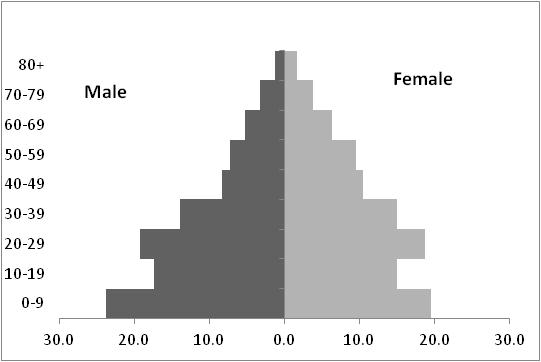
2014
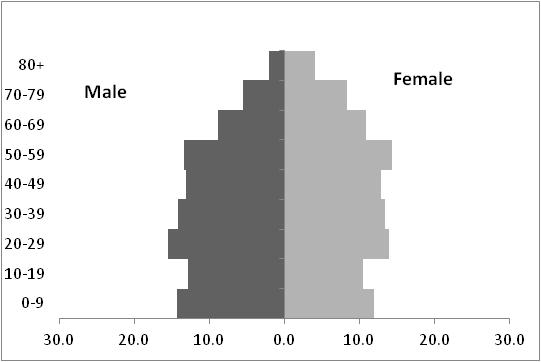
2050*
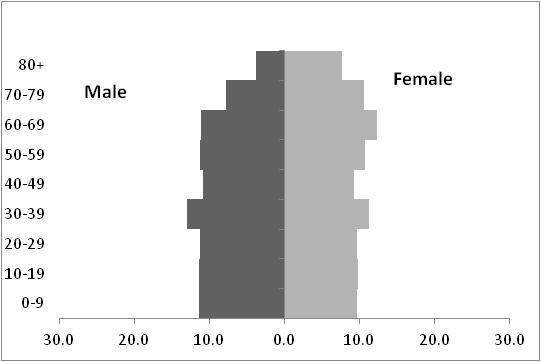
Sources: Population Censuses; * - (UN, 2017), custom data acquired via website.
The 1959 Population Census in Georgia shows that age-sex structure of population remains young and more than half of population was working age (15 years and over) population and Age-Sex pyramid was “Progressive”. In the next period the age structure of population has changed drastically and in 1989 the population pyramid has a “Stationary” face due to the low level of natural growth.
In Georgia, the first national census conducted in 2002 showed that the share of population aged 0-4 was reduced and the share of persons aged 65 and older was increased compared to 1989 and the age-sex pyramid was "Regressive". Herewith, starting from 1990 s the net migration is negative which in turn negatively affects the number of population and its structure.
In 2014, the Age-Sex Pyramid is "Constrictive" and population ageing process will continue rapidly by 2050.
According to the 2014 General Population census, the share of persons aged 65 years and older is 14.3% and it is twice higher than the UN standard, according to which the population is ageing when share of persons aged 65 years and older exceed 7% (Tsuladze, Maglapheridze, & Sulaberidze, 2007). According to projections, this indicator will reach 23% by 2050 (UN, 2017) and the Age dependency ratios will increase.
Figure 2: Age dependency ratios (per 100 populations 15-64)
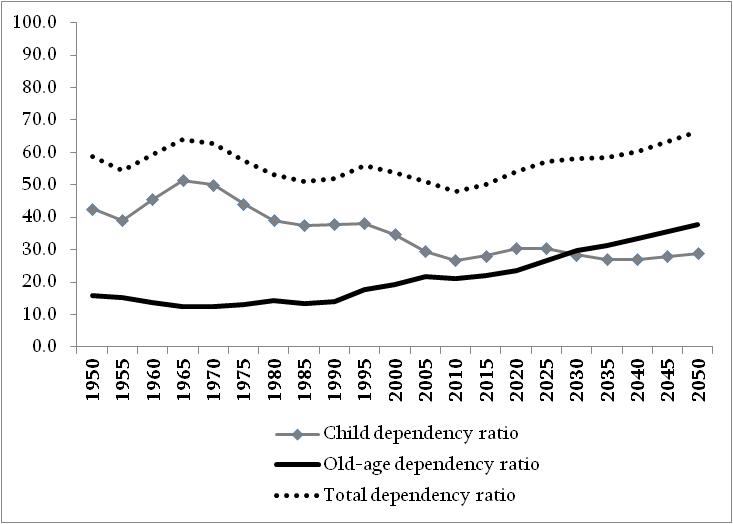
Source: (UN, 2017), custom data acquired via website.
In 1950, the Old-age dependency ratio was 16 and it increased to 22 for 2017 and process will continue and ratio will reach 37 by 2050. At the same period, the Child dependency ratio is going to decrease from 43 in 1950 to 22 in 2050. This led to the fact that the Total dependency ratio increases not at the expense of youth but at the expense of aging which negatively affects the country's economy.
Figure 3: Employed population by Employment Status and age (%)
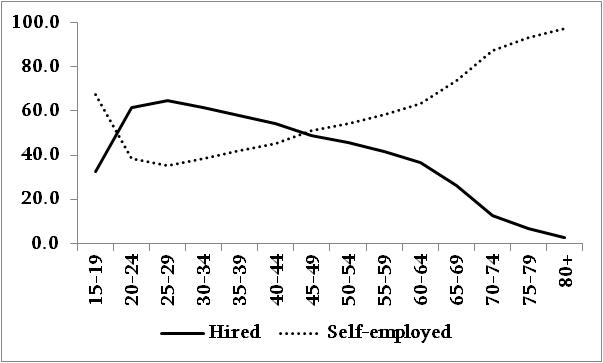
Source: 2014 General Population Census
According to the 2014 Population Census, the employment rate of 65 years and older is 45.3%, this figure is much higher in rural areas than in urban (69 and 21 respectively). In addition, their absolute majority (86.3%) are self-employed. Which is expected as almost half of the employed population (46.6%) is employed in agriculture sector and the majority of the elderly are among them.
All the above mentioned, it is important to analyze the intergeneration transfers. As the results of recent surveys conducted in Georgia shows that transfers are directed mainly from the older to younger generation. 55% of older respondents provide material and financial assistance to younger generation, while only a quarter of the younger generation provide assistance to the older generation (Shelia, 2013). The similar results were shown the study conducted by the Institute of Demography and Sociology, Ilia State University in 2015.
In general, a different demographic structure in urban and rural areas (urban population in Georgia is younger than in rural areas) reflects the revenues of urban and rural households and their contribution to the country's GDP. In Georgia, 42.8 percent of the population lives in rural areas but about 1/10 of the country's GDP is created in the agricultural sector and 4-5 percent from the other sector. So, the share of rural residents in the country's economy is about three times lower than their share in the total population. This is an adequate reflected in the income and welfare of households (Sulaberidze, 2017).
Some authors used an over-lapping generational model to examine the demographic impact on economy, in which, he asserted that population growth induces prosperity and welfare (Samuelson, 1975). This is because the growing population expands the tax base, and, in turn, accelerates the accumulation of capital transferable to retirees. Such economic benefit taken from the population growth is so called demographic dividend. Nonetheless, on the opposite of his hypothesis, once the population growth is in the era of stagnation, which subsequently leads to a declining ratio of workers to retirees, namely support ratio, the demographic dividend will then, sooner or later, be exhausted. Nowadays, the demographic dividend of Georgia slowly ends and problems of employment and social security of the second demographic dividend (population of 65 years and older) becoming actual (Sulaberidze, 2017). It should be taken into consideration that returning migrants in retirement age will increase the existing social loading on the budget. This situation is a challenge for modern Georgia, where economic well-being will be triggered by the aging population.
Conclusion
Demographically speaking, increasing fertility or immigration could be the solution to the threat of ageing as they are capable to extend the tax base and labour supply. However, as scholars argued, the former takes at least 25-30 years to start exerting positive effects, and the latter is likely to come along with additional problems, e.g. integration of immigrants to labour force, and increasing burden on health care and pension, which would largely offset the positive effect of immigration. At the same time out-migration flows is still higher than in-flows, but according to the projections and the Migration Transition theory the labour migrants left the country in 1990’s, which are now in retirement age, definitely will start the process of their returning. This will further deteriorate the regressive age structure of the population and increase the demographic trap for the country's economy.
Hence, demographic solutions seem insufficient to overcome such challenges, economic and policy adjustments are therefore needed. It is important to correct or develop a socio-economic policy taking into account the demographic challenges, in order to avoid prospective “demographic trap”.
References
- Bengtsson, T., & Scott, K. (2010). The Ageing Population. The Case of Sweden. Springer.
- Samuelson, P. A. (1975). The Optimum Growth Rate for Population. International Economic Review , vol. 16(3), pp. 531-38.
- Shelia, M. (2013). Elderly in Georgia. Problems of Demography and Sociology.
- Sulaberidze, A. (2017). Presentation on demographic trend and national accounts system in Georgia. The symposium “National transfer accounting: principles, methodology and the main problems of construction” organization . Higher Scool of Economics, Moscow: www.demoscope.ru.
- Sulaberidze, A., & Gomelauri, N. (2016). Demographic aging and peculiarities of the formation of the second demographic dividend in Georgia. Conference dedicated to the 70th anniversary of the Institute of Morphology of Alexander Natishvili. Tbilisi: TSU.
- Tsiklauri, S. (2013). Socio-demographic aspects of population ageing in Georgia. BOLD, Vol. 23 No. 3, pp. 24-28.
- Tsuladze, G., Maglapheridze, N., & Sulaberidze, A. (2007). Textbook of Demography. Tbilisi: Ilia State University.
- UN. (2017). World Population Prospects: The 2017 Revision. NY: United Nations, Department of Economic and Social Affairs.
- Рональд , Л., & Эндрю , М. (2017, Март ). Цена старения. Финансы и развитие, pp. 7-9.
